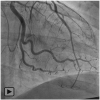Spontaneous coronary artery dissection with cardiogenic shock in the third trimester, and a successful early-term delivery: a case report
- PMID: 33733048
- PMCID: PMC7948075
- DOI: 10.1093/ehjcr/ytab080
Spontaneous coronary artery dissection with cardiogenic shock in the third trimester, and a successful early-term delivery: a case report
Abstract
Background: Acute myocardial infarction in pregnancy is occasionally due to spontaneous coronary artery dissection (SCAD). Although uncommon, the majority of cases of pregnancy-associated SCAD (pSCAD) has critical presentations with more profound defects that portend high maternal and foetal mortality, and frequently necessitate preterm delivery. This is a case of pSCAD with ongoing ischaemia that required temporary mechanical circulatory support (MCS) and emergent revascularization, while the pregnancy was successfully continued to early-term.
Case summary: A 30-year-old woman G2P1 at Week 32 of gestation with no medical history, presented to the emergency department with severe chest pain. An electrocardiogram showed ST-segment elevation in the anterolateral leads. An emergent cardiac catheterization revealed dissection of the proximal left anterior descending (LAD) artery with TIMI (thrombolysis in myocardial infarction) 3 flow. Although initially stable, she later experienced recurrent chest pain and developed cardiogenic shock, necessitating MCS, and emergent revascularization. She was stabilized and remained closely monitored in the hospital prior to vaginal delivery at early-term.
Discussion: This case of pSCAD at Week 32 of gestation complicated by refractory ischaemia illustrates the complexity of management, which requires a multi-disciplinary team to reduce both maternal and foetal mortality. Conservative management of SCAD, while preferred, is not always possible in the setting of ongoing ischaemia, particularly if complicated by cardiogenic shock. A thorough weighing of risks vs. benefits and ongoing discussions among multiple subspecialists in this case allowed for the stabilization of the patient and subsequent successful early-term delivery.
Keywords: ACS; Cardio-obstetrics; Case report; Revascularization; SCAD; Shock.
© The Author(s) 2021. Published by Oxford University Press on behalf of the European Society of Cardiology.
Figures





References
-
- Tweet MS, Hayes SN, Codsi E, Gulati R, Rose CH, Best PJ.. Spontaneous coronary artery dissection associated with pregnancy. J Am Coll Cardiol 2017;70:426–435. - PubMed
-
- Gilhofer TS, Saw J.. Spontaneous coronary artery dissection: a review of complications and management strategies. Expert Rev Cardiovasc Ther 2019;17:275–291. - PubMed
-
- Scott NS. Management of cardiovascular disease during pregnancy. US Cardiol Rev 2018;12:119–123.
Publication types
LinkOut - more resources
Full Text Sources
Other Literature Sources
